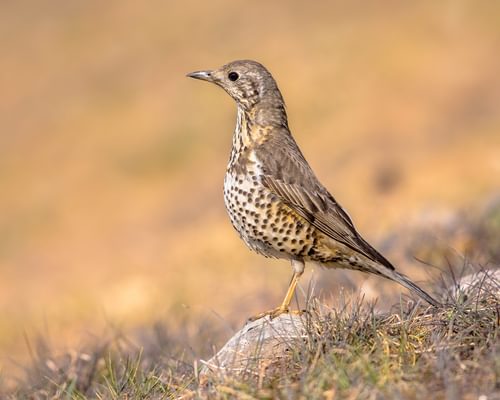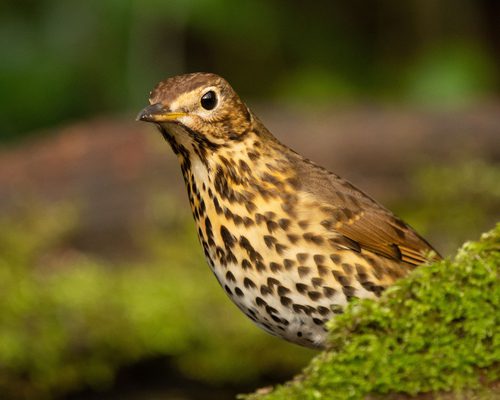Fieldfare
Turdus pilaris
Visual Identification
Appearance
The Fieldfare is a robust thrush with distinctive grey plumage on its head and rump, contrasting with chestnut-brown wings and back. Its breast is heavily spotted with black, fading to a white belly. The bird has a yellow bill with a dark tip and brown legs.
Both sexes look similar, with juveniles showing a more mottled appearance and less defined head colouration. In winter, the bill darkens to a brownish-yellow.
Size
Length
22cm to 27cm
Wingspan
39cm to 42cm
Weight
80g to 130g
Colours
Males and females have similar plumage
Primary Colour
Grey Brown
Secondary Colour
White Black
Beak Colour
Yellow Black
Leg Colour
Brown
Habitat and Distribution
Habitats
Woodland
Garden
Wetland
Coastal
Urban
Farmland
Grassland
Desert
Tundra
Rainforest
Mountain
Savanna
Distribution
Fieldfares breed across northern Europe and Asia, from Scandinavia to eastern Siberia. They prefer open woodland, forest edges, and parkland for nesting. During winter, many migrate south and west, with large numbers reaching the UK, where they inhabit open countryside, orchards, and gardens.
Fieldfares may push further south into southern Europe and occasionally North Africa in harsh winters. Some populations in central Europe are resident year-round.
Elevation Range
Up to 2,000 meters
Climate zones
Temperate, Subarctic
Distribution Map
This map gives you a rough idea of where you might spot a Fieldfare. The coloured areas show countries where these birds have been seen.
A few things to keep in mind:
- Birds might not be everywhere in the coloured areas, for example, they may be present around the coast of that country
- Where birds live can change with seasons and available food
- This map is quite simple - it doesn't show exact locations
We're working on making our maps even better! Soon, we hope to show you:
- More detailed maps for bigger countries, including state and region
- How birds move around during different seasons
Distribution by Region
Behaviour and Ecology
Bird Attributes
This feature is in beta. We'd love your feedback to improve it!
Share your thoughtsBird Attributes Explained
Our bird attributes system rates various aspects of a bird's capabilities on a scale of 0-100, based on data from field observations, scientific studies, and expert knowledge.
Attribute Categories:
- Agility: Manoeuvrability, speed, and grace in flight or movement.
- Strength: Physical power, often correlating with size and hunting abilities.
- Adaptability: Ability to thrive in various environments or changing conditions.
- Aggressiveness: Territorial behaviour and assertiveness, particularly during breeding seasons.
- Endurance: Stamina, often seen in migration patterns or foraging behaviours.
Understanding the Ratings:
- 0-20: Very Low
- 21-40: Low
- 41-60: Average
- 61-80: High
- 81-100: Very High
Remember, these attributes are relative to other bird species and don't necessarily indicate superiority.
Hover over the icon next to each attribute for more information.
Tap the icon next to each attribute for more information.
Agility
Reflects the bird's manoeuvrability, speed, and grace in flight or movement.
The Fieldfare demonstrates considerable agility in its foraging behaviour, hopping and running on the ground with ease. Their ability to quickly take flight when alarmed and perform display flights during breeding season further indicates good manoeuvrability.
Strength
Indicates the bird's physical power, often correlating with size and hunting abilities.
As a medium-sized thrush, the Fieldfare possesses moderate strength. Their robust build and ability to defend nests aggressively suggest decent physical power, though not exceptional compared to larger birds of prey.
Adaptability
Represents the bird's ability to thrive in various environments or changing conditions.
Fieldfares show high adaptability, thriving in various habitats from woodlands to urban areas. Their ability to switch diets seasonally and form large flocks in winter demonstrates flexibility in behaviour and survival strategies.
Aggressiveness
Measures the bird's territorial behaviour and assertiveness, particularly during breeding seasons.
Fieldfares exhibit notable aggression, particularly in nest defence. Their tendency to mob predators and even spray faeces at intruders indicates a strong protective instinct. However, outside breeding season, they are generally less confrontational.
Endurance
Reflects the bird's stamina, often seen in migration patterns or foraging behaviours.
The Fieldfare's partial migratory nature and ability to form large winter flocks suggest good endurance. Their capacity to survive harsh winters by seeking shelter and adapting their diet indicates moderate to good stamina, though not exceptional compared to long-distance migrants.
Diet
Fieldfares are omnivorous, and their diet varies seasonally. In summer, they primarily consume invertebrates such as earthworms, insects, and snails.
During autumn and winter, they switch to a fruit-based diet, favouring berries from rowan, hawthorn, and juniper trees. These berries are often taken directly from hedges, trees, and bushes, although windfall apples are also a favourite.
Behaviour
Fieldfares are highly social birds, often seen in large flocks during winter. They forage on the ground, hopping and running in search of food.
When alarmed, they give a characteristic 'chack-chack' call and fly off together, displaying their white underwings.
Vocalisation
The Fieldfare's call is a harsh, chattering 'chack-chack-chack', often given in flight or when alarmed. Their song heard mainly in breeding areas, is a softer, warbling melody interspersed with clicks and whistles, somewhat reminiscent of a Blackbird but less musical.
Nesting & Breeding
Fieldfares breed from May to July, often in loose colonies for added protection against predators. Males perform display flights and sing to attract mates. Nests are typically built in tree forks or on branches, constructed with grass, moss, and mud.
Females lay 5-6 pale blue eggs with brown speckles. Both parents share incubation duties, which last about 13 days. The chicks are altricial and remain in the nest for another 12-15 days before fledging.
Fieldfares are known for their aggressive nest defence, often mobbing potential predators and even spraying faeces at intruders.
Conservation and Status
Global Conservation Status
While the Fieldfare is currently listed as Least Concern, it faces threats from habitat loss due to agricultural intensification and climate change. Conservation efforts focus on maintaining suitable breeding habitats and protecting important European wintering grounds.
Birdwatching Tips
- Look for large flocks in open fields during winter
- Listen for their distinctive 'chack-chack' alarm call
- Observe their habit of suddenly flying up from the ground when disturbed
- In the UK, check berry-laden trees and hedgerows in autumn and winter
Additional Information
Quick Facts
Predators
Main predators include birds of prey such as Sparrowhawks and Goshawks, as well as mammals like foxes and martens. Domestic cats can also pose a threat in urban and suburban areas.
Did You Know?
- Fieldfares can form winter flocks of up to 10,000 individuals.
- Their scientific name, Turdus pilaris, refers to their round shape and hair-like feathers.
- In severe weather, Fieldfares have been known to seek shelter in abandoned buildings or dense vegetation.
Similar Birds
References
- 1 2
website: BirdLife International. 2016. Turdus pilaris. The IUCN Red List of Threatened Species 2016: e.T22708816A87874379.
View source - 3
report, 2015: EBCC
Share Your Feedback
We value your opinion! Let us know what you think about this bird page.

